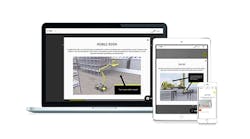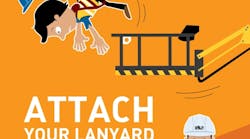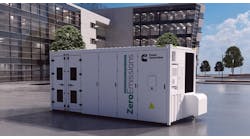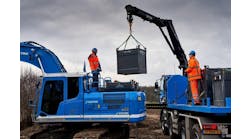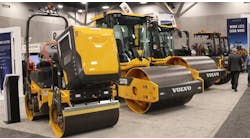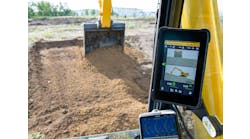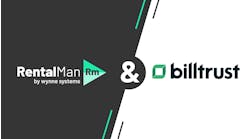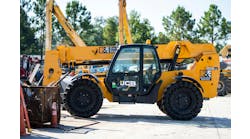What New ANSI A92 Standards Will Mean to Your Rental Center
(Editor’s Note: More than five years and thousands of man-hours in the making, the proposed new ANSI A92 Mobile Elevating Work Platform (MEWP) Design, Safe-use and Training Standards will be published in spring 2017. With wide-ranging changes being introduced, these standards will have a 12-month effective date after publication to allow the industry to become compliant with the new requirements.
Tony Groat, ANSI A92.22 Safe-use Chairperson and North American manager of the International Powered Access Federation (IPAF), highlights some of the many things that we should know about in the new rules. According to Groat, the changes should not be labeled as good or bad; they are just different, and have been approved by the industry after much review and vetting.
It is important to note however, that the proposed standards have not yet been published and are still subject to change. Further, this article does not address all of the changes within the suite of standards, but rather key topics the author selected, so as to raise awareness of the scope of change to be addressed.)
While the incoming ANSI standards are not yet finalized, it is important for everyone who rents or operates aerial work platforms – now formally referred to mobile elevating work platforms – to be aware of how they will impact the rental industry.
The hierarchical structure of the next standards places the design standard as the lead, followed by safe use and then training standards. For instance, the design standard will require manufacturers to provide operations manuals, the safe-use standard will require that the manuals be maintained on the machine and that users read and understand them prior to use, and the training standard says that the required training must be performed. It can be rationalized that only manufacturers need to be fluent with the Design Standard, while all stakeholders need fluency with both the Safe-use and Training Standards.
While a user of lifts may not need to know how to manufacture the equipment, the new requirements in the A92.20 Design Standard will impact them. Here are a few changes in the design standard that are particularly impactful:
- The introduction of new nomenclature for groups and types of lifts;
- Move from proof testing to calculations-based designs;
- New requirement to provide work platform load-sensing system on all MEWPs;
- In addition to an audible alarm, MEWPs will be prevented from certain movement when reaching allowed limits of chassis inclination;
- Operator’s manual will include a listing of MEWP functions, features, operating characteristics, limitations and devices to be included in familiarization;
- A means shall be provided on the MEWP to mark the date the last annual inspection was performed and the interval at which inspections are required;
- MEWPs designed only for indoor use shall be clearly marked;
- NEW minimum rated load of a MEWP shall be 120 kg (264.5 lbs).
Even if you are not a manufacturer, you will be impacted by these new changes. Even the terminology you hear being used will be different, such as mobile elevating work platforms (MEWPs) instead of aerial work platforms (AWPs), or a classification “3b”, where MEWP types “1, 2 or 3” define the drivability of the MEWP with the work platform elevated, and “a” or “b” defines the work platform movement in relation to the chassis. This change will be easy to get used to once you know the simple key to the terminology.
A fundamental change in the design standard is a shift from safety-factor-based stability and calculations to an ISO standards-based stability and calculations that include wind load formulas. Formula-based designs will offer greater flexibility in the design of individual models in the future.
The introduction to mandatory work-platform load-sensing, however, may require a cultural change. Many of today’s designs define a maximum-rated work load, but do not prohibit work platforms being raised with a higher weight in the platform. The MEWP may be capable of lifting greater loads above the rated work load. The new load-sensing system will require a sensor that will activate and prevent drive and lift functions until the overload is removed, thus preventing this unapproved overloading.
Although a user/operator should not exceed the rated work load, if the MEWP can physically perform the task it can be assumed that heavier loads are being moved despite warnings. If this improper operation occurs with the platform in certain configurations, the MEWP can become unstable. This can become a serious issue, particularly if the load is transferred at height (i.e. taking down an air conditioning or heater unit). How will you remove that load? It will become critical to know the actual weight of all items to be carried in the work platform BEFORE placing into the platform, especially if adding a load at height.
A benefit of this design change is that with more accurate weight loading and smarter control systems that can identify the location of the boom, MEWP loading can allow for higher rated loads in various configurations.
Load-sensing systems will not be added without cost and they will require additional maintenance and training, but they clearly provide an engineered solution to risks from overloading, and they can provide increased rated workloads in various configurations. For those who follow the manufacturer’s requirements, this new requirement will bring added value to the equipment and safer use.
Also new in the ANSI A92.20 Standards, for Type 3 MEWPs at or beyond allowed limits of chassis inclination, a device shall prevent the MEWP from continuation of travel in the selected direction and, for Group A MEWPs, further elevation shall not be allowed. This will hopefully prevent MEWPs overturning when inappropriately driven on unlevel surfaces beyond the limits allowed by the manufacturer. Previously, tilt alarms would activate when the MEWP reached the inclination of the chassis limits permitted by the manufacturer, but the machine could still operate.
New requirements for operator manuals documentation require the manufacturer to provide a list of items that must be included in the familiarization of the machine. If you miss anything in the operator manual for familiarization, you are non-compliant. This checklist is relatively easy for operators to follow as opposed to reading and understanding the entire manual.
Though annual inspections have always been required, until now operators never knew if they had been completed, as there was no requirement to show when the annual inspection was last performed. The new standards will require the manufacturer to provide a means to mark the machine with the date of the last inspection, and owners must keep it up to date. Operators, inspectors and managers will then be able to check quite easily that the machine has been passed fit for use.
Another change is that an MEWP having a “zero wind” load-rating is an indicator that it cannot be used outdoors where winds can impact stability. The new standards require these machines to be clearly marked for “INDOOR USE ONLY”.
Last among the noted design changes is the movement from a minimum rated design load of 300 pounds to a load of 264.5 pounds, or 120 kilograms. This is not intended to reduce the required work platform loading, but rather to allow manufacturers to design machines that previous requirements restricted. Reaching higher or further are potential benefits that can come from this change. If the market wants 300-pound-rated machines they will still be available.
Changes in safe-use standards
Changes in the A92.22 safe use standard also offer a few significant issues that will impact all MEWP users
- Familiarization will be offered on request, rather than required to be provided by owners and dealers upon delivery;
- Users must allow operator time after familiarization to achieve operational proficiency;
- Only the owner can authorize a modification to a MEWP after meeting the requirement defined in the standard;
- The Manual of Responsibility is still required on all MEWPs;
- “Operation Manuals” term is introduced;
- Modifications are approved by the owner as required by the standard;
- Additional requirements for frequent and annual inspection;
- Means to ID when annual inspection completed is a new requirement;
- Additional requirements in a pre-start inspection;
- Risk assessment requirement and process;
- Supervisor training, occupant knowledge, and retraining;
- Expanded operator warnings and instruction.
While the Manual of Responsibilities (MoR) is not specifically stated in the Safe-use Standard, it is still required on all MEWPs. The “operation manuals” are required and the Design Standard states both the operator manual and the MoR at a minimum must be included. This is not a change in responsibility, only a change in the terminology.
The operation manuals are any documents that a manufacturer provides in the weather-proof compartment on the MEWP that are intended to communicates necessary safety information to users and operators. The design standard mandates these to include the operator’s manual and the SAIA Manual of Responsibilities. It could include other documents, all of which must be maintained on the MEWP and read and understood buy the user/operator.
Modifications to a MEWP can create hazards to the safe operation of a MEWP. They are now only allowed when authorized by the MEWP owner, after first obtaining written permission from the manufacturer. The net effect is that users and operators are excluded from any modification or addition to a MEWP without authorization of the owner.
Frequent and Annual inspections are the responsibility of the MEWP owner. Frequent inspections detail nine issues to address in an inspection. An annual inspection includes all of the requirements of a frequent inspection, plus additional items specified by the manufacturer and any safety bulletins. While some owners already place an annual inspection decal on their MEWPs, it is now a requirement in the new standards, and all owners must comply.
In the new standards, the daily pre-start inspection that the user shall ensure is completed and performed by the operator has a more explicit list of items to be addressed in the inspection. Six additional items and expanded language in existing bullets increase the items that an operator must address.
Worksite risk assessment required
One of the more significant additions to the standard is the requirement for users to perform a worksite risk assessment prior to operation of an MEWP. This is a detailed planning process that identifies potential hazards associated with the task to be performed and the development of means to eliminate or mitigate the risk from the hazards.
Planning includes the proper selection of the MEWP for the work, providing appropriate personal protective equipment, developing a rescue plan and communicating the plan with affected workers. While this should have been a safety practice already in place, the standard spells out this responsibility for users in a clear process. Industry associations developed a best practice for MEWP risk assessment years earlier, so this should not be a surprise in the industry.
Tied to risk assessments is the new requirement for supervisors of MEWP operators to receive training. Logic would dictate that one couldn’t meet the requirement to supervise, monitor, evaluate and warn MEWP operators of potential hazards if you are unaware of the safe use requirement. Language has also been added to the potential events that may require MEWP operator retraining beyond the evaluation of the MEWP supervisor.
Existing standards offer 37 topics for operator warnings and instructions. The new standard now includes supervisors and operators, and provides more details and additional topics in user responsibilities. As an example, existing standards only address “wind and weather” in daily workplace inspections, whereas the new standard addresses weather considerations, effects of wind forces on MEWPs and on equipment in the work platform, local wind effects and use in thunderstorms. Ground-condition considerations are addressed to include inadequate outrigger foundations, sub-surface voids and working on or near public roads.
There is now a recommendation (aka ‘should’) for the operator to use available devices to deactivate the controls on the work platform whenever possible when working at height, and to ensure proper ventilation at all times in enclosed areas.
Another significant addition is new language addressing exiting an MEWP at height. Previously this was exclusively allowed only if permitted by the manufacturer and following guidelines and instructions provided by the manufacturer. While not intending to repurpose an MEWP as an elevator, the new standard opens the industry to this procedure being more widely approved when following the guidelines defined in the standard.
The A92.24 Training Standard provides methods and guidelines to prepare MEWP training materials, defines administrative criteria, and delivers elements required for proper training. Some key topics of the training standard include:
- Safe use when training shall be in compliance with A92.22 Safe-use Standard;
- Training required by MEWP classification;
- Users ensure training can be understood by their workers and after training must evaluate operators on a regular basis and document;
- User shall ensure training is offered in a manner trainees can understand;
- Content of theory and practical training defined;
- Occupant knowledge required;
- Supervisor training defined;
- Administration of training defined;
- Sample training evaluation sheets and certificate of completion offered.
Those who offer and deliver training must be fluent with the requirements of this standard and users must ensure that training being provided to their workers comply with this new standard when it becomes effective.
The requirements for training include incorporating the responsibilities defined in the A92.22 Standard and require the delivery of training itself to be in compliance with the standard. An example of training in compliance with the Safe-use Standard is a trainer performing a site risk assessment for the work area where the practical training is being delivered, and communicating the potential hazards and the methods required to mitigate the risk with the operator trainees.
The standard also requires the user to select the training for their workers and ensure the training provided is appropriate for them to understand. As an example, if the worker does not understand the language that the training course is being delivered in, the user must provide an alternate course in the language of the trainee or arrange to have an interpreter available for the training. Further, after a trainee has successfully been trained, the user must designate a qualified person to monitor, supervise and evaluate operators on a regular basis to ensure their proficiency.
New in the standard is the requirement for MEWP operators to provide specific instructions to MEWP occupants so they can work safely on the MEWP. There are minimum guidelines of the required instructions to be provided.
A more significant addition is the requirement for the user to ensure that any personnel who supervise MEWP operators be trained. Supervisory training includes the responsibilities for both the user and operators to enable them to be qualified to monitor operator performance and supervise their work. The Training Standard also provides requirements for the general administration of training to include trainers, curriculum, training environment, test and documentation.
Tony Groat’s verdict: “MEWPs are now a worldwide product and the principles of safe use are the same wherever in the world they are used. The new ANSI Standards are a significant move by the U.S. to lead the way towards standardizing design, safe use and training requirements worldwide – a goal that is at the heart of IPAF’s purpose to promote the safe and effective use of powered access worldwide.
“This overview of the three-new proposed ANSI A92 MEWP standards is intended to increase awareness and offer a summary of a range of changes that all in the industry will need to begin to address to become compliant with these standards and improve the safe and effective use of MEWPs. The 12 months between publication and the effective date of these standards allows all to plan and take appropriate action to read, understand and implement their responsibilities as defined in them. Those 12 months will go by fast, so as a final note – don’t wait to take action, begin planning now.”
IPAF training for operators and managers key to ANSI compliance
One way to ensure compliance is for operators to hold a PAL Card and supervisors to obtain IPAF’s MEWPs for Managers (AWPs for Managers) qualification. IPAF PAL Cards –- the global industry standard in recognizing training and accreditation -- use Smart technology, which can help keep a digital log of what equipment the user has used and where, and can alert the holder when refresher training is due. Validity of PAL Cards can be verified online. Utilizing the latest generation of online learning tools, IPAF now offers operator trainees the option of completing the theory requirement of their training via an interactive eLearning module. Benefits of eLearning include:
- Candidates complete the eLearning module online – anytime, anywhere, on any device and at their own pace;
- Candidates can then complete the supervised hands-on practical test and evaluation at an approved training center to complete operator training;
- Operators don’t have to take so much time away from the job to complete training;
- In most cases necessary training can be concluded comfortably inside a few hours;
- Trainees opting for an instructor-led theory course also benefit from sessions enhanced by the interactive material in the online module.
- Available in English or Spanish.
In addition, IPAF’s MEWPs (AWPs) for Managers course fulfils the ANSI requirement for MEWP supervisor training. This course is a minimum of four hours; an online version of the course is currently being developed.
Tony Groat is North American Manager of the International Powered Access Federation (IPAF)

